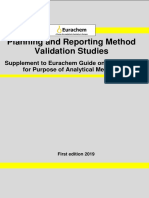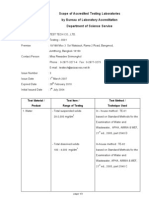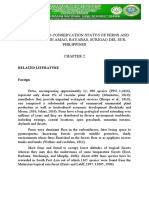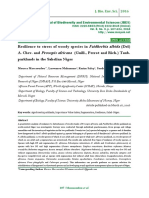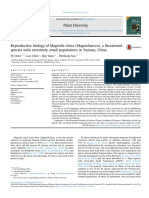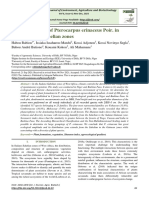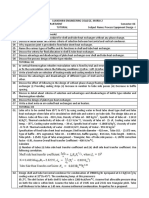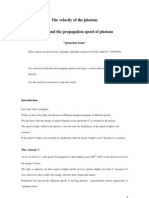Professional Documents
Culture Documents
Literature Review: The Distribution and Habitat Profiles of Anaphalis SPP
0 ratings0% found this document useful (0 votes)
44 views6 pagesThe aims of the research were to Identify the
species of Anaphalis found in Poncokusumo District,
profiling distribution of Anaphalis in Poncokusumo
Distri
Original Title
Literature Review the Distribution and Habitat Profiles of Anaphalis Spp. Outside Protected Forest in Poncokusumo Distrit, Malang Regency
Copyright
© © All Rights Reserved
Available Formats
PDF, TXT or read online from Scribd
Share this document
Did you find this document useful?
Is this content inappropriate?
Report this DocumentThe aims of the research were to Identify the
species of Anaphalis found in Poncokusumo District,
profiling distribution of Anaphalis in Poncokusumo
Distri
Copyright:
© All Rights Reserved
Available Formats
Download as PDF, TXT or read online from Scribd
0 ratings0% found this document useful (0 votes)
44 views6 pagesLiterature Review: The Distribution and Habitat Profiles of Anaphalis SPP
The aims of the research were to Identify the
species of Anaphalis found in Poncokusumo District,
profiling distribution of Anaphalis in Poncokusumo
Distri
Copyright:
© All Rights Reserved
Available Formats
Download as PDF, TXT or read online from Scribd
You are on page 1of 6
Volume 6, Issue 9, September – 2021 International Journal of Innovative Science and Research Technology
ISSN No:-2456-2165
Literature Review : The Distribution and Habitat
Profiles of Anaphalis Spp.
Outside Protected Forest In Poncokusumo Distrit, Malang Regency
Tin Nang Oo
Brawijaya University: Graduated Departement
Malang City, Indonesia
Abstract:- The aims of the research were to Identify the I. INTRODUCTION
species of Anaphalis found in Poncokusumo District,
profiling distribution of Anaphalis in Poncokusumo Anaphalis (or Edelweiss, by local language) is one of the
Distrit, and describing habitat of Anaphalis in threatened plants from Asteraceae group which found in
Poncokusumo District. The benefit of this research is the mountains area. Their native distribution was in sub-montana
availability of baseline data as a reference for until alpin zone, also grows as pioneer species in volcanic
enforcement of conservation measures for Anaphalis soils (Hakim & Miyakawa., 2013). In East Java, especially the
species found in Poncokusumo. Conservation steps that Tengger Mountains, there are three types of Anaphalis
can be taken include socialization of the local community, scattered, including A. javanica, A. longifolia, and A. viscida
(Ade et al., 2019). Of the three species, A. javanica has been
habitat protection and population monitoring. The field
designated as one of the flora protected by the government
survey was carried out in October-December 2020 by
through P.106 / MENLHK / SETJEN / KUM.1 / 12/2018
measuring several plots in the area found by Anaphalis. (KLHK, 2020), while the other two types still do not have
Each site was analyzed for vegetation by measuring the legal status. clear. In addition, the three Anaphalis species
density, frequency and cover of plants. Plant species have not been recorded in the IUCN Redlist database
included in the quadratic plot of 1x1 m2 were identified. (Pardianti et al., 2014), so research related to the distribution
In addition, microclimate factors were recorded, such as of Anaphalis has an important aspect of urgency.
temperature, humidity and light intensity as well as
altitude, coordinate points, soil type and land slope. The distribution of Anaphalis in the Tengger Mountains
Interviews with the local people, We interviewed has been recorded in four locations in the Bromo-Tengger-
informant especially was key person around we found Semeru National Park conservation area (Ade et al, 2019), but
Anaphalis habitat. We conducted a face-to-face semi- the field study shows distribution found outside protected area,
structured questionnaire and asked our informants to ask in highland farmlands area in Poncokusumo district. Those
about the distribution, uses and functions, and community location still categorized as a buffer zone beyond the Bromo-
conservation efforts of Anaphalis. Data analysis, Tengger-Semeru National Park. In the buffer zone, the wild of
Vegetation analysis to know composition of plant species Anaphalis can easily risk to decrease by impact of human
inside quadrates for determining diversity index, pressure and natural disaster as an effect of low protection
important value index, dominance and everlasting of status of the area. In some cases of human pressure, Roziaty &
plant. Abiotic factors that have been measured are shown Wijaya (2019) shows if Anaphalis flowers are taken for drying
and illegally commercialized as souvenirs and collections. In
in tabular form as a comparison between distribution
addition, Anaphalis is also potentially threatened by habitat
locations. Information from interview with local person
loss due to high anthropogenic activity and natural disasters,
was interpreted qualitatively descriptive. Some of the especially fire and erosion (Pardianti et al., 2014). This
conservation opportunities in the strategy are policy condition requires an action as a solution to maintain the
support for biological conservation and the ecotourism existence of Anaphalis. These lead Poncokusumo is a crucial
movement, threat aspects such as reduced control of land area for the ex-situ conservation of Anaphalis beyond
functions in mass tourism. In this study, the SWOT conservation area.
analysis provides recommendations on significant
strategies that come from a combination of strengths and As far, the are no complete data related to the species
optimizing opportunities, and reducing weaknesses and diversity of Anaphalis and its distribution in Poncokusumo
optimizing opportunities so that strengths reduce threats Villages. There is also poor information related to the habitat
and manage risks. condition of Anaphalis. This research can also be used as
baseline data to support conservartion action plans for
Keywords:- Bromo, Anaphalis Spp, Distribution, Tengger. Anaphalis.
IJISRT21SEP227 www.ijisrt.com 306
Volume 6, Issue 9, September – 2021 International Journal of Innovative Science and Research Technology
ISSN No:-2456-2165
The aims of the research were to Identify the species of Sumatra there are only two types, namely longiolia and
Anaphalis found in Poncokusumo District, profiling javanica (Tjitrosoedirjo, 2000). This was done by taxonomy
distribution of Anaphalis in Poncokusumo Distrit, and on Mount Talang in Sumatra and also found the same thing. In
describing habitat of Anaphalis in Poncokusumo District. The some specimens there are also deficiencies that cannot be
benefit of this research is the availability of baseline data as a detected in the morphology of longifolia or javanica
reference for enforcement of conservation measures for characteristics due to natural hybrids of the two types such as
Anaphalis species found in Poncokusumo. Conservation steps internode spacing, width, growth pattern, leaf, underside, and
that can be taken include socialization of the local community, filarial. In the distance of the internodes and the width and
habitat protection and population monitoring. The Anaphalis pattern in javanica, but on the leaves, and the color of the tip is
population found can be proposed to be a special flora of the more similar to longifolia. In comparisons or comparisons
Poncokusumo area. It can be also influenced due coordinative between morphologies that are often used, evidence of
policy for the protection of this species in the future. In hybridization is found (Taufiq A, 2009, Encheva, 2005, Gong,
addition, Anaphalis can also be proposed to be a regional 2008, Hamilton, 2013). From a morphological perspective,
tourism object of special interest by raising the use value and things like this hybrid show the relationship between
symbols of Anaphalis. individual characteristics but it is necessary to see some
morphologies develop and evolve by convergent and
II. LITERATURE REVIEW environmental selection, not by hybridization (Du, Zhang,
2012). The factors that occur in the environment greatly affect
2.1 Edelweiss flower (Anaphalis spp.) the morphology, this is always correct, of course it is very
Anaphalis is a genus in the Asteraceae family. There are difficult to know which hybrids are morphologically real. So it
more than 110 species in the genus of plants that exist in will be very difficult to conclude that morphological evidence
Central and South Asia (Nesom, 2006) and several species can be used as reference material. Recently, anatomical
that exist in North America and are very popularly cultured. methods have become the closest and most widely used
There are two species, namely javanica and longifolia, which method of confirming research results from natural hybrids.
can be found in the mountains in Indonesia, especially on the This is because the existing data anchor more accurate data
island of Java. Javanica is a species that has the potential to because of the anatomical features used in the hybrids in the
become extinct, Anaphalis javanica, with a name more case of nothofagus bliqua, oerst, and galuca (Donoso, 1979).
commonly known as java edelweiss or commonly called
senduro, which is a flora that is in alpine or montane in the Carrying out an approach that is quite multiple and
mountains (Nesom, 2006). varied in nature can increase the accuracy of the naturally
occurring hybrid which is thought to be an anaphalist made by
These plants can reach a height of 8 meters can have a the authors. Hybrids of longifolia and javanica from Gunung
stem like a large human foot, but can not be more than 1 meter Talang have been found with anatomical features of leaves
for the trunk. Edelweiss is a pioneer of volcanic soil in the and stems that are in natural hybrid status. The characteristics
forest and is able to provide wealth to the soil that is barren of the two things, especially the leaves and stems, are cross-
soil that will be improved by volcanic activity. This can give sectional and paradermal by the method. Through this
the formation of mycorrhizae on fungi and soil and is not research, there are seven characteristics of natural hybrids in
effective for area expansion by roots which can perform order to determine the layer of cells, the length of the cortex to
efficiency and to absorb higher nutrients. The flowers that the width of the cuku is similar to longifolioa but there is a
exist in April and August can be very favored by more than characteristic of javanica, namely the flower layer, and the
300 types of insects such as bees, butterflies, wasps, and bees combination of the two, namely all the characteristics that
that perch on these flowers. In this plant, if it manages to support longifolia and javanica in terms of hybrids.
increase or maintain branch strength, it will become a nesting
place for several insects such as Myophonus glaucinus. The diversity of life in Indonesia is also because it is the
highest and most abundant in the world, this is because
Edelweiss flowers are too often plucked and brought Indonesia is on the equator, which is used as the center of flora
down and from the mountain for aesthetic reasons for spiritual and fauna in the world. Anaphalis sp. Is a plant that grows in
reasons, and are considered as memories for climbers. From the highlands of this plant is a typical flora of the mountains.
February to October in 1988 636 were uprooted or taken from The population in Indonesia is still quite large, especially on
Mount Gede Pangrango and it is a place with plants which is the islands of Java and Sumatra. Anaphalis is a plant with
the ultimate protection. To a certain extent the small pieces herbaceous and woody flowers in the Asteraceae family,
used can still be tolerated, in the Tengger Semeru National which is a family of the large flowered flora of Malesiana
Park, this species or plant has become extinct. This has (Tjitrosoedirdjo, 2002), which is a plant with phenylal
happened to be the cause of the greed of the population, characteristics that is widespread from Europe and America.
especially those on small roads, this study can show that Anaphalis is a special thing, one of which is a distinctive and
edelweiss can be propagated by cutting branches, therefore the long-lasting smell after being picked, from the community it is
remnants are sold to visitors to reduce pressure on the used as a souvenir from the mountain (Sulistyawati et al
population. The best places are edelweiss in the form of 2017). Through patterns of anaphalic and random ecology, as
Papandayan, Gde, Plawangan Sembalun, and Mandalawangi. well as clusters, the distribution pattern in the community
refers to the condition of plants in an environment. For the
Anaphalis is part of the Asteraceae. Lives in the tropics pattern in distribution is very closely related to the
which can grow up to 3,600 MDPL. This condition can environment. The types of organisms between places are also
survive at a fairly low nutrient content because it is combined very related and dependent, and if a community gives a
with mycorrhizae (Van steenis, 1972). In the area of origin of disturbance or also other environmental factors it will have an
IJISRT21SEP227 www.ijisrt.com 307
Volume 6, Issue 9, September – 2021 International Journal of Innovative Science and Research Technology
ISSN No:-2456-2165
impact on the whole community. This is evidenced in several However, this is at an altitude of 1000 MDPL will find
studies conducted in several places, one of which is in North changes in temperature with this altitude can cause the belt to
Sumatra Province, in several districts such as Samosir, Toba the bioclimatic is also full and given a replacement on another
Samosir, and Karo with longifolia populations (Prakarsa et al belt. At a certain compression of a certain area to the gradient
2018). Other research was also conducted in the area of Mount of altitude and the diversity of plant species greatly exceeds
Papandayan, where habitat conditions are threatened. There the existing lowland types. Of course, out of 32% of the
are many people who live in the forest environment using it as world's protected areas are mountainous areas which
one of the equipment for regional ceremonies (Pramita et al increasingly show the distance between all of these things.
2013). 20% of the entire population in the world also live in
mountainous areas, of course, most of them live in the
On Mount Lawu is also one of the ones on the island of lowlands. There are more than ninety million people who live
Java which is located in 3 regencies, namely Ngawi, Magetan, in areas with an altitude above 2,500 MDPL and live in
and Karanganyar, on this mountain there are a lot of flora and poverty, which is a number with a very high vulnerability to
fauna, in order to reach the peak you can pass the Cemoro food security. There is a lot of history in the past that tells
Sewu climb, where one of the favorite flora when climbing about the growing economy of mountainous communities.
through this path is anaphalis which is at an altitude of 2,800 However, special efforts to maintain agricultural production in
masl. This research was carried out to 1) differentiate the locations with a fairly high altitude close to the level of the top
Anaphalis species on the Cemoro Sewu climb; 2) Studying the tree line, and the economy in lowland communities gives more
various distributions of Anaphalis on Mount Lawu which is on dominance to mountainous areas, although there are several
the Cemoro Sewu border in Karanganyar and Magetan other things such as exploitation of mountain resources that
districts. The process of anaphalis conservation in the Bromo rarely occur which is very dangerous. benefit the local
Tengger Semeru National Park area really needs an community.
understanding and deepening of the habitat of these plants.
This study aims to explain the original habitat of anaphalis in 2.3 Biodiversity Conservation
the Bromo Tengger Semeru mountain area. In this study, three Biodiversity conservation is the protection and
types of anaphalis were identified, namely javanoca, viscida, management of biodiversity to obtain resources for sustainable
and longifolia. This species is found in climbing, shell, and development.
ranu kumbolo. In the habitat of this research area, there are
other influencing variables, namely volcanic. Anaphalis can Biodiversity conservation has three main objectives:
grow on muddy, clay, dusty, and sandy plants. This plant • To preserve the diversity of species.
grows by having very high competition against weeds with • Sustainable utilization of species and ecosystem.
exotic plant species. There are several competitors in exotic • To maintain life-supporting systems and essential
plant species, namely agrotis sp., imperata, pteridium sp., ecological processes.
Alchemilla sp., these plants play a role in being a competitor
to the growth of anaphalis in their natural habitat and require Biodiversity refers to the variability of life on earth. It can
massive action to minimize competing species in anphalis be conserved in the following ways:
habitat. • In-situ Conservation
• Ex-situ Conservation
2.2 Mountain Environment and Its Ecosystem
According to the World Conservation Center at the United In-situ Conservation
Nations, about 23% of the world's land surface is In-situ conservation of biodiversity is the conservation of
mountainous. From altitude, it can be grouped into 3 types, species within their natural habitat. In this method, the natural
namely latitude and rainfall which will affect the vegetative ecosystem is maintained and protected.
growth of plants, which are as follows:
1. The mountain range that extends from the lower boundary The in-situ conservation has several advantages.
to the upper forest boundary Following are the important advantages of in-situ
2. Mountains which are areas without trees and forests with a conservation:
pure climate with snow; as well as 1. It is a cost-effective and a convenient method of
3. It is a nival area which is a snow area conserving biodiversity.
2. A large number of living organisms can be conserved
Conditions at elevation and slope are natural processes simultaneously.
of mountain ranges, but latitude and distance across the oceans 3. Since the organisms are in a natural ecosystem, they can
are local climates that make many mountains almost evolve better and can easily adjust to different
rainforest, some dry, and some seasonal. Sourced from environmental conditions.
geological substrates which provide a view of the diversity of
species and the influence of soil, erosion, and vegetation Certain protected areas where in-situ conservation takes
cover. In many mountains, natural processes such as erosion, place include national parks, wildlife sanctuaries and
landslides, mud, and rocks will greatly affect environmental biosphere reserves.
conditions, especially for spatial areas including temporal. In
this process, increasing volcanic activity will also make it the National Parks
main determining actor in mountainous areas which in These are small reserves maintained by the government.
geology have a young age and are steep. The vegetative Its boundaries are well demarcated and human activities such
process of a low mountain is very possible to get similarities as grazing, forestry, habitat and cultivation are prohibited. For
with the lowland areas around the area. eg., Kanha National Park, Bandipur National Park.
IJISRT21SEP227 www.ijisrt.com 308
Volume 6, Issue 9, September – 2021 International Journal of Innovative Science and Research Technology
ISSN No:-2456-2165
Wildlife Sanctuaries landscapes, recreational value, or the absence of alternative
These are the regions where only wild animals are economic uses of the landscape. Over the past two decades,
found. Human activities such as timber harvesting, cultivation, however, there has been a growing effort to protect important
collection of woods and other forest products are allowed here landscapes according to scientifically rigorous criteria;
as long as they do not interfere with the conservation project. biodiversity mapping has been a critical tool in this effort.
Also, tourists visit these places for recreation.
Biodiversity mapping involves the cartographic
Biosphere Reserves representation of species distributions and/or other
Biosphere reserves are multi-purpose protected areas environmental characteristics as proxies for biodiversity.
where the wildlife, traditional lifestyle of the inhabitants and Further data, such as information on human use of the land,
domesticated plants and animals are protected. Tourist and can also be incorporated in the analysis. These layers of data
research activities are permitted here. are typically entered into a geographic information system
(GIS) in order to generate maps that can be used to answer the
Ex-situ Conservation conservation questions at hand. There remain many barriers to
Ex-situ conservation of biodiversity involves the producing useful biodiversity maps: the very notion of
breeding and maintenance of endangered species in artificial biodiversity is not easily quantifiable; there is a profound lack
ecosystems such as zoos, nurseries, botanical gardens, gene of environmental data for certain elements of ecosystems and
banks, etc. There is less competition for food, water and space many parts of the world, and often the quality of available data
among the organisms. is poor. Much of the debate surrounding biodiversity mapping
focuses on how to approach the problem of imperfect data and
Ex-situ conservation has the following advantages: how the notion of biodiversity can best be represented. In
1. The animals are provided with a longer time and breeding particular, at what scale, and with what surrogate measures,
activity. can we best quantify biodiversity in ways that provide
2. The species bred in captivity can be reintroduced in the meaningful answers to conservation questions?
wild.
3. Genetic techniques can be used for the preservation of III. METHODS OF RESEARCH
endangered species.
3.1 Study Area
Strategies for Biodiversity Conservation This study area located in Poncokusumo District,
Following are the important strategies for biodiversity Malang Regency. Poncokusumo is one of the buffer zones on
conservation: the west side of Bromo Tengger Semeru National Park
1. All the varieties of food, timber plants, livestock, (BTSNP) with a landscape including settlements, agricultural
microbes and agricultural animals should be conserved. land, and production forests. Determination of the research
2. All the economically important organisms should be
site is done by selecting a possible location for Anapahalis to
identified and conserved.
grow outside protected area because the habitat is likely to
3. Unique ecosystems should be preserved first.
4. The resources should be utilized efficiently. experience degradation due to human modification.
5. Poaching and hunting of wild animals should be
prevented.
6. The reserves and protected areas should be developed
carefully.
7. The levels of pollutants should be reduced in the
environment.
8. Deforestation should be strictly prohibited.
9. Environmental laws should be followed strictly.
10. The useful and endangered species of plants and animals
should be conserved in their nature as well as artificial
habitats.
11. Public awareness should be created regarding biodiversity
conservation and its importance.
2.4 BIODIVERSITY MAPPING
The term 'biodiversity mapping' encompasses a variety
of techniques used to represent and analyze patterns of Figure 1. Maps of study area and habitat of Anaphalis.
biodiversity, and is almost always used within the framework
of environmental conservation. Although maps of biodiversity
can be useful simply as a way to represent complex Based on the results of the preliminary survey, the
environmental data in an easily interpretable form, usually distribution of Anaphalis was found in 3 villages, namely
biodiversity mapping involves further analysis and Wringinom (Kunci), Poncokusumo, and Sumberejo (Jajang).
manipulation of the data in order to answer specific The characteristics of the Anaphalis habitat are sloping land
conservation questions. Out of necessity, some areas must be with dominant grassy vegetation with rocks that have some of
prioritized over others in terms of their conservation value. soil as a substrate found in Poncokusumo sub-district can be
Until recently, this was done on a largely ad hoc basis with
found on slopes under bamboo (Kunci), around pine forests
ecosystems receiving protection largely because of dramatic
IJISRT21SEP227 www.ijisrt.com 309
Volume 6, Issue 9, September – 2021 International Journal of Innovative Science and Research Technology
ISSN No:-2456-2165
(Poncokusumo 1, Poncokusumo 2 & Jajang 2) and around in line with the goals of shara'. Furthermore, Edelweiss
agricultural land (Jajang 1). flowers can be used by making them as research material,
developing cultivation or even being used as medicine if it is
3.2 Field survey really needed. In line with the conclusions above, the Ministry
The field survey was carried out in October-December of Forestry of the Bromo Tengger Semeru National Park
2020 by measuring several plots in the area found by Center of Malang Regency, the East Java Provincial Forestry
Anaphalis. Each site was analyzed for vegetation by Service, the East Java Provincial Environment Agency, and
measuring the density, frequency and cover of plants. Plant other stakeholders should reinforce the applicable laws and
species included in the quadratic plot of 1x1 m2 were regulations so that perpetrators of biodiversity crimes can be
identified. In addition, microclimate factors were recorded, minimized. Sellers, buyers, and visitors to the Bromo tourist
such as temperature, humidity and light intensity as well as area should be smarter and more careful in utilizing the
altitude, coordinate points, soil type and land slope. biodiversity that exists inside and outside the Mount Bromo
tourism conservation area. In order to preserve biodiversity,
3.3 Interviews with the local people especially plants that are protected or not protected, we should
We interviewed informant especially was key person not take, pick, bring home, or trade anything that is inside or
around we found Anaphalis habitat. We conducted a face-to- outside the conservation area.
face semi-structured questionnaire and asked our informants
to ask about the distribution, uses and functions, and 4.3 Morphological Study of Anaphalis Javanica at Several
community conservation efforts of Anaphalis. Altitudes
In a study conducted by (Maulidan, 2015) This study
3.4 Data analysis was compiled using a completely randomized design (CRD)
Vegetation analysis to know composition of plant One way Anava, by observing the differences in morphology
species inside quadrates for determining diversity index, and anatomy of the leaves of Javanese Edelweiss (Anaphalis
important value index, dominance and everlasting of plant. javanica) namely leaf length and width, stomata density,
Abiotic factors that have been measured are shown in tabular stomata index, stomata length and width. Sampling was taken
form as a comparison between distribution locations. at two different places, namely Mount Batok and Resort
Information from interview with local person was interpreted Cemoro Lawang. This research was conducted in April –
qualitatively descriptive. September 2010, located in the Bromo Tengger Semeru
National Park Area and the Optical Laboratory of the Islamic
IV. RESULTS AND DISCUSSION University (UIN) Maliki Malang. The data analysis technique
used One way Anava analysis and if the treatment had a
4.1 Habitat Anaphalis spp. In Tourism Area in Bromo significant effect, then continued with the BNT test with a
Tengger Semeru National Park, East Java significance level of 0.05.
Referring to research (Hamzah, 2010) conservation of
Anaphalis in the Bromo Tengger Semeru national area The results showed that there were differences in leaf
requires knowledge of the habitat. This study aims to describe morphology and leaf anatomy of Javanese Edelweiss
the profile of the condition of Anaphalis spp in the area. This (Anaphalis javanica) at each station with different heights,
study also confirmed that there were three species that had namely leaf length and width, stomata density, stomata index,
been identified, namely javanica, longifolia, and viscida. This stomata length, and stomata width. At Gunung Batok the
species is found on the ascent of Mount Batok and Ranu stomata density is low followed by large stomata size, while at
Kumbolo. This is certainly strongly influenced by volcanic Cemoro Lawang Resort the stomata density is denser and
activity. This plant can thrive in areas with high competition followed by smaller stomata sizes.
specifications for nutrients with weeds and other exotic plants.
4.4 Anaphalis spp. Conservation Strategy At Bromo Tengger
4.2 There is a sale and purchase of Anaphalis Javanica flowers Semeru
at Mount Bromo Tengger Semeru Tourism Several previous studies and analysis of several
The research conducted by (Ade et al., 2019) shows the literatures, such as research (Ade, 2021) showed that one of
results that the buying and selling actions carried out by the factors that can be used for conservation strategies is
descriptive analysis and inductive thinking patterns cause internal factors such as the presence of species and the value
damage. environment because Edelweiss is a pioneer plant and of Anaphalis spp., and the weakness is the high increase in
a growing medium for plants and soil fertility. In addition, the habitat degradation in tourism.
impact of natural or environmental damage caused will take
many victims, both in the form of property and lives caused by Some of the conservation opportunities in the strategy
erosion and landslides. So, buying and selling Edelweiss are policy support for biological conservation and the
flowers is not allowed in Islam based on an analysis of ecotourism movement, threat aspects such as reduced control
maslahah and mafsadah in order to take advantage and reject of land functions in mass tourism. In this study, the SWOT
damage or harm. Thus, trading Edelweiss flowers does not analysis provides recommendations on significant strategies
have. The problem in particular, but has a large mafsadah or that come from a combination of strengths and optimizing
madarat, is the destruction of the mountain ecosystem. So it is opportunities, and reducing weaknesses and optimizing
logically said that, all forms of exploitation of the Edelweiss opportunities so that strengths reduce threats and manage
plant are a form of mafsadah that must be rejected and are not risks.
IJISRT21SEP227 www.ijisrt.com 310
Volume 6, Issue 9, September – 2021 International Journal of Innovative Science and Research Technology
ISSN No:-2456-2165
V. CONCLUSSION [8]. Tjitrosoedirjo, S.S. 2000. The Asteraceae of Sumatera.
Post Graduate Programme. Institut Pertanian Bogor.
Indonesia.
Referring to research conservation of Anaphalis in the [9]. Taufiq, A. 2009. Studi Taksonomi Edelweis (Anaphalis
Bromo Tengger Semeru national area requires knowledge of spp.) di Sumatera Barat. Skripsi Sarjana Biologi.
the habitat. This study aims to describe the profile of the FMIPA Universitas Andalas. Padang
[10]. Taufiq, A. 2009. Studi Taksonomi Edelweis (Anaphalis
condition of Anaphalis spp in the area. This study also spp.) di Sumatera Barat. Skripsi Sarjana Biologi.
confirmed that there were three species that had been FMIPA Universitas Andalas. Padang.
identified, namely javanica, longifolia, and viscida. This [11]. Encheva, J., Christov, M. 2005. Intergeneric hybrids
species is found on the ascent of Mount Batok and Ranu between cultivated sunflower (Helianthus annulus L.)
and Verbesina helianthoides (genus verbesina)
Kumbolo. In line with the conclusions above, the Ministry of morphological and biochemical aspects. Helia. 28(42):
Forestry of the Bromo Tengger Semeru National Park Center 27-36, doi: 10.2298/ HEL 0542027E.
of Malang Regency, the East Java Provincial Forestry Service, [12]. Pan, Y., Shi, S., Gong, XX., Kuroda, C. 2008. A natural
the East Java Provincial Environment Agency, and other hybrid between Ligularia paradoxa and L. duciformis
(Asteraceae, Senecioneae) from Yunnan, China. Annals
stakeholders should reinforce the applicable laws and of the Missouri Botanial Garden. 95(3): 487-494,
regulations so that perpetrators of biodiversity crimes can be http://dx.doi.org/10.3417/ 2006034.
minimized. Sellers, buyers, and visitors to the Bromo tourist [13]. Du, G., Zhang, Z., Li, Q. 2012. Morphological and
molecular evidence for natural hybridization in
area should be smarter and more careful in utilizing the sympatric population of Roscoea humeana and R.
biodiversity that exists inside and outside the Mount Bromo cautleoides (Zingiberacea). J. Plant Res. 125: 595- 603,
tourism conservation area. In order to preserve biodiversity, doi: 10.1007/s10265-012-0478-6
especially plants that are protected or not protected, we should [14]. Hamilton, J.A., Aitken, S.N. 2013. Genetic and
morphological structure of a spruce hybrid (Picea
not take, pick, bring home, or trade anything that is inside or sitchensis x P. glauca) one along a climatic gradient.
outside the conservation area. [15]. Am. J. Bot. 100(8): 1651-166, doi: 10.3732/ajb.
1200654.
[16]. Hoyo, Y., Tsuyuzaki, S. 2013. Characteristics of leaf
Some of the conservation opportunities in the strategy shapes among two parental Drosera species and hybrid
are policy support for biological conservation and the examined by canonical discriminantanalysis and a
ecotourism movement, threat aspects such as reduced control hierarchical bayesian model. Am. J. Bot. 100(5): 817-
of land functions in mass tourism. In this study, the SWOT 823, doi: 10.3732/ajb.1200510.
[17]. Song, Y., Deng, M., Hipp, A.L., Li, Q. 2015. Leaf
analysis provides recommendations on significant strategies morphological evidence of natural hybridization
that come from a combination of strengths and optimizing between two oak species (Quercus
opportunities, and reducing weaknesses and optimizing austrocochinchinensis and Q. kerrii) and its implications
opportunities so that strengths reduce threats and manage for conservation management. Eur. J. Forest Res. 134:
139-151, doi 10.1007/s10342-014-0839-x.
risks. [18]. Donoso, S., Landrum, L.R. 1979. Nothfagus leoni
Espinosa, a natural hybrid between Nothofagus oblique
REFERENCES (Mirb.) Oerst. and Nothfagus glauca (Phil.)
[19]. Krasser. N.Z. J. Bot. 17: 353-360, http://dx.doi.
org/10.1080/0028825x. 1979. 10426908.
[1]. Hakim, L., &Miyakawa, H. (2013). Plant trees species [20]. Alix, M.S., Scribailo, R.W. 2006. First report of
for restoration program in Ranupani, Bromo Tengger Potamogeton x Undulatus (P. Crispus x P. Praelongus,
Semeru National Park Indonesia. Biodiversity Journal, Potamogetonaceae) in North America, with notes on
4(3), 387-394. morphology and stem anatomy. Rhodora. 108(936):
[2]. Ade, Filza Y., L. Hakim., E. L. Arumingtyas & R. 329-346, http://dx.doi.org/10. 3119/0035-
Azrianingsih. 2019. Habitat Anaphalis spp. in Tourism 4902(2006)108(329:FROPUP)2.0.CO:2.
Area in Bromo Tengger Semeru National Park, East [21]. Cetzal-Ix, W., Carnevali, G., Noguera-Savelli, E.,
Java. J-PAL, 10(2), 137-141 Jauregui, D. 2013. Morphological and anatomical
[3]. Pardianti, R., D. T. Adriyani & A. Syahbudin. 2014. characterization of new natural hibrid between
Persebaran Edelweiss (Anaphalis spp.) Pada Sub Tipe [22]. Cohniella ascendens dan C. brachyphylla (Oncidiinae :
Hutan Montana Dan Alpin Di Taman Nasional Gunung Orchidaceae). Phytotaxa. 144(2): 45- 55,
Gede Pangrango. Prosiding Seminar Nasional http://dx.doi.org/10.11646/phytotaxa.144.2.2
Silvikultur II P13, 350-355. [23]. Ade, F.Y., 2021. Conservation strategy of Anaphalis
[4]. Roziaty, E & N. M. Wijaya. 2019. Diversity and spp. in Bromo Tengger Semeru National Park, East
distribution pattern of Anaphalis sp. (Edelweis) in the Java. J. Trop. Life Sci. 11.
Cemoro Sewu Climbing Track in Mount Lawu [24]. Ade, F.Y., Hakim, L., Arumingtyas, E.L., Azrianingsih,
Magetan, East Java, Indonesia. Eurasia J Biosci 13, R., 2019. Habitat Anaphalis spp. in Tourism Area in
1755-1762. Bromo Tengger Semeru National Park, East Java. J.
[5]. KSDAE. 2020. Peraturan Menteri 106 (2018). Pembang. Dan Alam Berkelanjutan 10.
Http://www. Ksdae.menlhk.go.id. Acessed on 29 [25]. Hamzah, M.F., 2010. Studi morfologi dan anatomi daun
September 2020. edelweis Jawa (Anaphalis javanica) pada beberapa
[6]. Nesom, Guy L. (2006). "Anaphalis". In Flora of North ketinggian yang berbeda di Taman Nasional Bromo
America Editorial Committee, eds. 1993+ (ed.). Flora of Tengger Semeru.
North America. 19. New York & Oxford: Oxford [26]. Maulidan, N., 2015. ANALISIS MASLAHAH DAN
University Press. p. 426. MAFSADAH TERHADAP JUAL BELI BUNGA
[7]. Van steenis, C.G.G.J. 1972. The Mountain Flora of EDELWEIS (ANAPHALIS JAVANICA) DI WISATA
Java. Leiden: E.J. Brill. GUNUNG BROMO (TAMAN NASIONAL BROMO
TENGGER SEMERU).
IJISRT21SEP227 www.ijisrt.com 311
You might also like
- Quality Assurance Manual For Indiana Wastewater LaboratoriesDocument93 pagesQuality Assurance Manual For Indiana Wastewater LaboratoriesdhikaNo ratings yet
- Eurachem 2019 PDFDocument32 pagesEurachem 2019 PDFStoyanovaNo ratings yet
- Audit Internal R10 MANLABDocument7 pagesAudit Internal R10 MANLABM Aysar FerdiansyahNo ratings yet
- E 1812 Standard Practice For Optimization of Flame Atomic Absorption Spectrometric EquipmentDocument2 pagesE 1812 Standard Practice For Optimization of Flame Atomic Absorption Spectrometric EquipmentBryan Mesala Rhodas GarciaNo ratings yet
- QC 3 001d-DraftDocument29 pagesQC 3 001d-DraftPravilNo ratings yet
- ISO/IEC 17043 Conformity Assessment Requirements for Proficiency TestingDocument18 pagesISO/IEC 17043 Conformity Assessment Requirements for Proficiency TestingMukhamad Muslim HabibieNo ratings yet
- As 3580.7.1-1992 Methods For Sampling and Analysis of Ambient Air Determination of Carbon Monoxide - Direct-RDocument2 pagesAs 3580.7.1-1992 Methods For Sampling and Analysis of Ambient Air Determination of Carbon Monoxide - Direct-RSAI Global - APACNo ratings yet
- PDF Apha AwwaDocument60 pagesPDF Apha AwwaKen Ople100% (1)
- Distributiondiversityandabundanceoffernsin USMDocument15 pagesDistributiondiversityandabundanceoffernsin USMNiezl Mae Dimzon DelgadoNo ratings yet
- Rapid Assessment of Epiphytic Pteridophyte Biodiversity in Mt. Apo Natural Park North Cotabato Province Philippines A Comparison of Disturbed and Undisturbed ForestsDocument14 pagesRapid Assessment of Epiphytic Pteridophyte Biodiversity in Mt. Apo Natural Park North Cotabato Province Philippines A Comparison of Disturbed and Undisturbed ForestsKayla Patreece NocomNo ratings yet
- 2 46 1649671725 5ijbrjun202205Document10 pages2 46 1649671725 5ijbrjun202205TJPRC PublicationsNo ratings yet
- Polylepis Incana Kunth and Polylepis Racemosa Ruiz Pav ReforestedDocument15 pagesPolylepis Incana Kunth and Polylepis Racemosa Ruiz Pav Reforestedca.lalamaNo ratings yet
- Tropical Agricultural Science: Pomacea Maculata (Gastropoda: Ampullariidae) in A Rice FieldDocument7 pagesTropical Agricultural Science: Pomacea Maculata (Gastropoda: Ampullariidae) in A Rice Fieldrattus argentiventerNo ratings yet
- Species Richness and Distribution of Primates in Disturbed and Converted Forest Landscapes in Northern BorneoDocument11 pagesSpecies Richness and Distribution of Primates in Disturbed and Converted Forest Landscapes in Northern Borneonadaraja1706No ratings yet
- 15 2taufiq 2013 FloribundaDocument10 pages15 2taufiq 2013 FloribundaAanden NuvapuNo ratings yet
- Alvez-Ferreira Et Al 2021 Morphological Characterization and Diversity of Tadpoles at PNEDocument11 pagesAlvez-Ferreira Et Al 2021 Morphological Characterization and Diversity of Tadpoles at PNEFausto NomuraNo ratings yet
- 2022 Article 4934Document14 pages2022 Article 4934Javier MartinNo ratings yet
- Biblio HG 60 GohreDocument28 pagesBiblio HG 60 GohreSergio JituNo ratings yet
- Species Composition and Distribution of Zingiberaceae in Mt. Hamiguitan Expansion Site, Davao Oriental, PhilippinesDocument17 pagesSpecies Composition and Distribution of Zingiberaceae in Mt. Hamiguitan Expansion Site, Davao Oriental, PhilippinesSiti MujdalipahNo ratings yet
- Philippine endemic gingers documented in Mt. HamiguitanDocument6 pagesPhilippine endemic gingers documented in Mt. HamiguitanSittie SiradNo ratings yet
- Ecology and Evolution - 2020 - Diriba - Diversity of Medium and Large Mammals in The Loka Abaya National Park SouthernDocument10 pagesEcology and Evolution - 2020 - Diriba - Diversity of Medium and Large Mammals in The Loka Abaya National Park SouthernDiego VazquezNo ratings yet
- Assessing Mangrove Diversity in Nogas IslandDocument7 pagesAssessing Mangrove Diversity in Nogas IslandTeresa Marie Yap CorderoNo ratings yet
- Species Diversity of Odonata in Bolyok Falls, Naawan, Misamis Oriental, PhilippinesDocument8 pagesSpecies Diversity of Odonata in Bolyok Falls, Naawan, Misamis Oriental, PhilippinesKristal Cay AragonNo ratings yet
- 9-Fernandez Et Al. 2017 Azorella-Laretia-Mulinum Phylogeny-MPEDocument21 pages9-Fernandez Et Al. 2017 Azorella-Laretia-Mulinum Phylogeny-MPEMartina FernandezNo ratings yet
- Journal Homepage: - : IntroductionDocument11 pagesJournal Homepage: - : IntroductionIJAR JOURNALNo ratings yet
- Aribal Fernando 2014 Vascularplantsofthepeatswampforestin Caimpugan Agusandel Sur Provinceon Mindanao Island PhilippinesDocument18 pagesAribal Fernando 2014 Vascularplantsofthepeatswampforestin Caimpugan Agusandel Sur Provinceon Mindanao Island PhilippinesMaureene Andrea AllamNo ratings yet
- Rubiaceae Flore of Northern Sierra MadreDocument15 pagesRubiaceae Flore of Northern Sierra MadreRachel BiagNo ratings yet
- Species Diversity and Spatial Structure of Intertidal Mollusks in Padada, Davao Del Sur, PhilippinesDocument10 pagesSpecies Diversity and Spatial Structure of Intertidal Mollusks in Padada, Davao Del Sur, PhilippinesYayan MardiansyahNo ratings yet
- Checklist and Conservation Status of Ferns and Lycophytes in AmagDocument4 pagesChecklist and Conservation Status of Ferns and Lycophytes in AmagPerlita CaneteNo ratings yet
- Forest Ecology and Management: Carolina Soliani, Giovanni G. Vendramin, Leonardo A. Gallo, Paula MarchelliDocument12 pagesForest Ecology and Management: Carolina Soliani, Giovanni G. Vendramin, Leonardo A. Gallo, Paula MarchelliJoelma SilvaNo ratings yet
- Assessment of Mangrove Species and Its Relation To Soil Substrates in Malapatan, Sarangani Province, PhilippinesDocument8 pagesAssessment of Mangrove Species and Its Relation To Soil Substrates in Malapatan, Sarangani Province, PhilippinesInternational Network For Natural SciencesNo ratings yet
- Medicinal Palms (Arecaceae) in Madagascar - Undocumented or Underutilized?Document9 pagesMedicinal Palms (Arecaceae) in Madagascar - Undocumented or Underutilized?LastriNo ratings yet
- Comparative chloroplast DNA phylogeography of two tropical pioneer treesDocument13 pagesComparative chloroplast DNA phylogeography of two tropical pioneer treesAlbert MangopangNo ratings yet
- ARTICULO Cientifico SobreDocument7 pagesARTICULO Cientifico SobreJavier GarzonNo ratings yet
- Vegetation Inventory of Some Communities in Obudu Lga, Cross River StateDocument363 pagesVegetation Inventory of Some Communities in Obudu Lga, Cross River StateAkomaye Ferdinand100% (1)
- Faidherbia Albida Prosopis AfricanaDocument18 pagesFaidherbia Albida Prosopis AfricanaMd Ashikur RahmanNo ratings yet
- A Preliminary Study of The Odonata of S'Albufera Natural Park, PDFDocument10 pagesA Preliminary Study of The Odonata of S'Albufera Natural Park, PDFOshLifin RucmanaNo ratings yet
- Comparative study of Fern Species Diversity in Two WatershedsDocument21 pagesComparative study of Fern Species Diversity in Two WatershedsKimberly MartinezNo ratings yet
- Reproductive Biology of A Bromeligenous Frog Endemic To The Atlantic ForestDocument14 pagesReproductive Biology of A Bromeligenous Frog Endemic To The Atlantic ForestamandasantiagoNo ratings yet
- Species AbundanceDocument11 pagesSpecies AbundanceJohn Roi PeñafloridaNo ratings yet
- Native Trees On MT LantoyDocument13 pagesNative Trees On MT LantoyJa LuoNo ratings yet
- Plants Used as Insect Repellents by Indigenous PeopleDocument8 pagesPlants Used as Insect Repellents by Indigenous PeopleMarc Muriel RuadoNo ratings yet
- Research Progress of Plant Population Genomics Based On High-Throughput SequencingDocument12 pagesResearch Progress of Plant Population Genomics Based On High-Throughput SequencingLeidy Tatiana Garcia NavarreteNo ratings yet
- General Ecology FINAL EXAMINATION Article ReviewDocument2 pagesGeneral Ecology FINAL EXAMINATION Article ReviewRomnickCelestinoNo ratings yet
- Diversity and Ecological Status of Bryophytes in Mt. Kitanglad, Bukidnon, PhilippinesDocument31 pagesDiversity and Ecological Status of Bryophytes in Mt. Kitanglad, Bukidnon, PhilippinesKennethRavanillaNo ratings yet
- The Vegetation of Mt. Maculot, Cuenca, Batangas, PhilippinesDocument5 pagesThe Vegetation of Mt. Maculot, Cuenca, Batangas, PhilippinesApril Rose PlacerNo ratings yet
- Diet and parasite analysis of invasive frog species in Butuan CityDocument29 pagesDiet and parasite analysis of invasive frog species in Butuan CityJulian Valmorida Torralba IINo ratings yet
- Diversity and Species Composition of Spiders (Arachnida: Aranaeae) at Different Habitats in Mount Tumpa Forest Park, North Sulawesi, IndonesiaDocument10 pagesDiversity and Species Composition of Spiders (Arachnida: Aranaeae) at Different Habitats in Mount Tumpa Forest Park, North Sulawesi, IndonesiaMd Ashikur RahmanNo ratings yet
- Chen Et Al 2016Document6 pagesChen Et Al 2016tio_conejolsvNo ratings yet
- Diversity and Distribution of Pteridophytes along an Altitudinal GradientDocument22 pagesDiversity and Distribution of Pteridophytes along an Altitudinal GradientAlleah Grace JuguanNo ratings yet
- Naturalized and Invasive Alien Flora of GhanaDocument15 pagesNaturalized and Invasive Alien Flora of Ghanamiftha amiliaNo ratings yet
- 12-Calviño Et Al. 2018 Alnus-Biological InvasionsDocument8 pages12-Calviño Et Al. 2018 Alnus-Biological InvasionsMartina FernandezNo ratings yet
- Sample Concept PaperDocument6 pagesSample Concept PaperNoel Francis LabisNo ratings yet
- Plant Formations of Pterocarpus Erinaceus Poir. in Sudanian and Sahelian ZonesDocument13 pagesPlant Formations of Pterocarpus Erinaceus Poir. in Sudanian and Sahelian ZonesMamta AgarwalNo ratings yet
- Caballero Et Al. 2019Document11 pagesCaballero Et Al. 2019ancginiNo ratings yet
- Superficial ConclusionDocument49 pagesSuperficial ConclusionIngrid ParissNo ratings yet
- 196212-Article Text-495167-1-10-20200526Document12 pages196212-Article Text-495167-1-10-20200526Abubakar AdanNo ratings yet
- Dispersal Traits Determine Passive Restoration Trajectory of A Nigerian Montane ForestDocument9 pagesDispersal Traits Determine Passive Restoration Trajectory of A Nigerian Montane ForestsebastianNo ratings yet
- Article1409231295 - Peque and HölscherDocument11 pagesArticle1409231295 - Peque and HölscherHarper Mattheus QuinnNo ratings yet
- MBI 2021 Espinoza-Amen Etal CorrectedproofDocument20 pagesMBI 2021 Espinoza-Amen Etal CorrectedproofRené Oscar Rodriguez GrimónNo ratings yet
- Advancing Healthcare Predictions: Harnessing Machine Learning for Accurate Health Index PrognosisDocument8 pagesAdvancing Healthcare Predictions: Harnessing Machine Learning for Accurate Health Index PrognosisInternational Journal of Innovative Science and Research TechnologyNo ratings yet
- Diabetic Retinopathy Stage Detection Using CNN and Inception V3Document9 pagesDiabetic Retinopathy Stage Detection Using CNN and Inception V3International Journal of Innovative Science and Research TechnologyNo ratings yet
- Comparatively Design and Analyze Elevated Rectangular Water Reservoir with and without Bracing for Different Stagging HeightDocument4 pagesComparatively Design and Analyze Elevated Rectangular Water Reservoir with and without Bracing for Different Stagging HeightInternational Journal of Innovative Science and Research TechnologyNo ratings yet
- Design, Development and Evaluation of Methi-Shikakai Herbal ShampooDocument8 pagesDesign, Development and Evaluation of Methi-Shikakai Herbal ShampooInternational Journal of Innovative Science and Research Technology100% (3)
- Terracing as an Old-Style Scheme of Soil Water Preservation in Djingliya-Mandara Mountains- CameroonDocument14 pagesTerracing as an Old-Style Scheme of Soil Water Preservation in Djingliya-Mandara Mountains- CameroonInternational Journal of Innovative Science and Research TechnologyNo ratings yet
- Cyberbullying: Legal and Ethical Implications, Challenges and Opportunities for Policy DevelopmentDocument7 pagesCyberbullying: Legal and Ethical Implications, Challenges and Opportunities for Policy DevelopmentInternational Journal of Innovative Science and Research TechnologyNo ratings yet
- The Impact of Digital Marketing Dimensions on Customer SatisfactionDocument6 pagesThe Impact of Digital Marketing Dimensions on Customer SatisfactionInternational Journal of Innovative Science and Research TechnologyNo ratings yet
- The Utilization of Date Palm (Phoenix dactylifera) Leaf Fiber as a Main Component in Making an Improvised Water FilterDocument11 pagesThe Utilization of Date Palm (Phoenix dactylifera) Leaf Fiber as a Main Component in Making an Improvised Water FilterInternational Journal of Innovative Science and Research TechnologyNo ratings yet
- Dense Wavelength Division Multiplexing (DWDM) in IT Networks: A Leap Beyond Synchronous Digital Hierarchy (SDH)Document2 pagesDense Wavelength Division Multiplexing (DWDM) in IT Networks: A Leap Beyond Synchronous Digital Hierarchy (SDH)International Journal of Innovative Science and Research TechnologyNo ratings yet
- Formulation and Evaluation of Poly Herbal Body ScrubDocument6 pagesFormulation and Evaluation of Poly Herbal Body ScrubInternational Journal of Innovative Science and Research TechnologyNo ratings yet
- Auto Encoder Driven Hybrid Pipelines for Image Deblurring using NAFNETDocument6 pagesAuto Encoder Driven Hybrid Pipelines for Image Deblurring using NAFNETInternational Journal of Innovative Science and Research TechnologyNo ratings yet
- Electro-Optics Properties of Intact Cocoa Beans based on Near Infrared TechnologyDocument7 pagesElectro-Optics Properties of Intact Cocoa Beans based on Near Infrared TechnologyInternational Journal of Innovative Science and Research TechnologyNo ratings yet
- Explorning the Role of Machine Learning in Enhancing Cloud SecurityDocument5 pagesExplorning the Role of Machine Learning in Enhancing Cloud SecurityInternational Journal of Innovative Science and Research TechnologyNo ratings yet
- A Survey of the Plastic Waste used in Paving BlocksDocument4 pagesA Survey of the Plastic Waste used in Paving BlocksInternational Journal of Innovative Science and Research TechnologyNo ratings yet
- A Review: Pink Eye Outbreak in IndiaDocument3 pagesA Review: Pink Eye Outbreak in IndiaInternational Journal of Innovative Science and Research TechnologyNo ratings yet
- Navigating Digitalization: AHP Insights for SMEs' Strategic TransformationDocument11 pagesNavigating Digitalization: AHP Insights for SMEs' Strategic TransformationInternational Journal of Innovative Science and Research TechnologyNo ratings yet
- Automatic Power Factor ControllerDocument4 pagesAutomatic Power Factor ControllerInternational Journal of Innovative Science and Research TechnologyNo ratings yet
- Hepatic Portovenous Gas in a Young MaleDocument2 pagesHepatic Portovenous Gas in a Young MaleInternational Journal of Innovative Science and Research TechnologyNo ratings yet
- Studying the Situation and Proposing Some Basic Solutions to Improve Psychological Harmony Between Managerial Staff and Students of Medical Universities in Hanoi AreaDocument5 pagesStudying the Situation and Proposing Some Basic Solutions to Improve Psychological Harmony Between Managerial Staff and Students of Medical Universities in Hanoi AreaInternational Journal of Innovative Science and Research TechnologyNo ratings yet
- Review of Biomechanics in Footwear Design and Development: An Exploration of Key Concepts and InnovationsDocument5 pagesReview of Biomechanics in Footwear Design and Development: An Exploration of Key Concepts and InnovationsInternational Journal of Innovative Science and Research TechnologyNo ratings yet
- The Effect of Time Variables as Predictors of Senior Secondary School Students' Mathematical Performance Department of Mathematics Education Freetown PolytechnicDocument7 pagesThe Effect of Time Variables as Predictors of Senior Secondary School Students' Mathematical Performance Department of Mathematics Education Freetown PolytechnicInternational Journal of Innovative Science and Research TechnologyNo ratings yet
- Mobile Distractions among Adolescents: Impact on Learning in the Aftermath of COVID-19 in IndiaDocument2 pagesMobile Distractions among Adolescents: Impact on Learning in the Aftermath of COVID-19 in IndiaInternational Journal of Innovative Science and Research TechnologyNo ratings yet
- Enhancing the Strength of Concrete by Using Human Hairs as a FiberDocument3 pagesEnhancing the Strength of Concrete by Using Human Hairs as a FiberInternational Journal of Innovative Science and Research TechnologyNo ratings yet
- Drug Dosage Control System Using Reinforcement LearningDocument8 pagesDrug Dosage Control System Using Reinforcement LearningInternational Journal of Innovative Science and Research TechnologyNo ratings yet
- Securing Document Exchange with Blockchain Technology: A New Paradigm for Information SharingDocument4 pagesSecuring Document Exchange with Blockchain Technology: A New Paradigm for Information SharingInternational Journal of Innovative Science and Research TechnologyNo ratings yet
- Intelligent Engines: Revolutionizing Manufacturing and Supply Chains with AIDocument14 pagesIntelligent Engines: Revolutionizing Manufacturing and Supply Chains with AIInternational Journal of Innovative Science and Research TechnologyNo ratings yet
- Formation of New Technology in Automated Highway System in Peripheral HighwayDocument6 pagesFormation of New Technology in Automated Highway System in Peripheral HighwayInternational Journal of Innovative Science and Research TechnologyNo ratings yet
- Perceived Impact of Active Pedagogy in Medical Students' Learning at the Faculty of Medicine and Pharmacy of CasablancaDocument5 pagesPerceived Impact of Active Pedagogy in Medical Students' Learning at the Faculty of Medicine and Pharmacy of CasablancaInternational Journal of Innovative Science and Research TechnologyNo ratings yet
- Supply Chain 5.0: A Comprehensive Literature Review on Implications, Applications and ChallengesDocument11 pagesSupply Chain 5.0: A Comprehensive Literature Review on Implications, Applications and ChallengesInternational Journal of Innovative Science and Research TechnologyNo ratings yet
- The Making of Self-Disposing Contactless Motion-Activated Trash Bin Using Ultrasonic SensorsDocument7 pagesThe Making of Self-Disposing Contactless Motion-Activated Trash Bin Using Ultrasonic SensorsInternational Journal of Innovative Science and Research TechnologyNo ratings yet
- The Ansairetic MysteryDocument17 pagesThe Ansairetic MysteryBatulicin100% (1)
- Solar EnergyDocument8 pagesSolar EnergyNadeem ButtNo ratings yet
- Ocean's Impact On Climate Activity Worksheet: Part OneDocument3 pagesOcean's Impact On Climate Activity Worksheet: Part OneAaron CoxNo ratings yet
- Lab4 MIN277Document29 pagesLab4 MIN277Jhordy Romero GabrielNo ratings yet
- Sustainable Planning & Architecture: Notes Prepared by Ar. Achilles Sophia M.GDocument33 pagesSustainable Planning & Architecture: Notes Prepared by Ar. Achilles Sophia M.GVijay VNo ratings yet
- Prabharani Public SchoolDocument30 pagesPrabharani Public SchoolMainak RayNo ratings yet
- Engineering Geology: IntroductionDocument14 pagesEngineering Geology: IntroductionLyn GarciaNo ratings yet
- Listen and understand important details from conversations and passagesDocument3 pagesListen and understand important details from conversations and passagesHa TranNo ratings yet
- A Stress Rifting Origin of Grand Canyon - 2016 - Science BulletinDocument10 pagesA Stress Rifting Origin of Grand Canyon - 2016 - Science BulletinandresNo ratings yet
- Determining Soil Texture by FeelDocument4 pagesDetermining Soil Texture by FeelKy TaNo ratings yet
- Heat of Combustion of Liquid Hydrocarbon Fuels by Bomb CalorimeterDocument10 pagesHeat of Combustion of Liquid Hydrocarbon Fuels by Bomb CalorimetersaderfendeNo ratings yet
- Answer Key: PHYSICS 1050 Mid-Term Test 2Document8 pagesAnswer Key: PHYSICS 1050 Mid-Term Test 2hey_hopNo ratings yet
- Lecture 1 1489485680Document52 pagesLecture 1 1489485680Dato TevzadzeNo ratings yet
- Indian Energy ScenarioDocument19 pagesIndian Energy ScenarioVishal RamakrishnanNo ratings yet
- TOEFL Readings 28Document4 pagesTOEFL Readings 28Seni Dan OlahragaNo ratings yet
- How To Determine BasicityDocument10 pagesHow To Determine Basicityccy9489No ratings yet
- Notes On CeramicsDocument11 pagesNotes On Ceramicsleebrown21082003No ratings yet
- Chapter Three: Economic DispatchDocument15 pagesChapter Three: Economic Dispatchsagar0% (1)
- 1 s2.0 S0001868613001140 Main PDFDocument11 pages1 s2.0 S0001868613001140 Main PDFBEN DUNCAN MALAGA ESPICHANNo ratings yet
- Challenges of DR Industry in Me Emirates SteelDocument11 pagesChallenges of DR Industry in Me Emirates SteelJose Hurtado OjedaNo ratings yet
- Ped QuestionsDocument11 pagesPed QuestionsYashPatel100% (1)
- The Velocity of The Photons. "Quantum Foam"Document18 pagesThe Velocity of The Photons. "Quantum Foam"José Luís Pereira Rebelo FernandesNo ratings yet
- Ridge Push and Slab PullDocument3 pagesRidge Push and Slab PullKatrina ChowNo ratings yet
- Blackbody Radiation History & LawsDocument2 pagesBlackbody Radiation History & LawsMinoGerminaNo ratings yet
- Mc3 Chapter 1Document7 pagesMc3 Chapter 1Lorraine RiegoNo ratings yet
- Thermal_Physics_-_Revision__Document5 pagesThermal_Physics_-_Revision__jainamjainNo ratings yet
- CO2 Conversion and Utilization-American Chemical Society (2002)Document427 pagesCO2 Conversion and Utilization-American Chemical Society (2002)Nguyen TrangNo ratings yet
- NPCIL's Role in Meeting India's Growing Energy NeedsDocument8 pagesNPCIL's Role in Meeting India's Growing Energy NeedsNikunjNo ratings yet
- Reading Climatographs Worksheet StudentDocument6 pagesReading Climatographs Worksheet Studentstephanie ramirez50% (2)
- Sy 2022 2023 - 2Q - GP1 - Set Ab ExamDocument9 pagesSy 2022 2023 - 2Q - GP1 - Set Ab ExamLucaney Sectel HannahNo ratings yet
- Why We Die: The New Science of Aging and the Quest for ImmortalityFrom EverandWhy We Die: The New Science of Aging and the Quest for ImmortalityRating: 3.5 out of 5 stars3.5/5 (2)
- 10% Human: How Your Body's Microbes Hold the Key to Health and HappinessFrom Everand10% Human: How Your Body's Microbes Hold the Key to Health and HappinessRating: 4 out of 5 stars4/5 (33)
- The Molecule of More: How a Single Chemical in Your Brain Drives Love, Sex, and Creativity--and Will Determine the Fate of the Human RaceFrom EverandThe Molecule of More: How a Single Chemical in Your Brain Drives Love, Sex, and Creativity--and Will Determine the Fate of the Human RaceRating: 4.5 out of 5 stars4.5/5 (515)
- The Consciousness Instinct: Unraveling the Mystery of How the Brain Makes the MindFrom EverandThe Consciousness Instinct: Unraveling the Mystery of How the Brain Makes the MindRating: 4.5 out of 5 stars4.5/5 (93)
- Crypt: Life, Death and Disease in the Middle Ages and BeyondFrom EverandCrypt: Life, Death and Disease in the Middle Ages and BeyondRating: 4 out of 5 stars4/5 (3)
- When the Body Says No by Gabor Maté: Key Takeaways, Summary & AnalysisFrom EverandWhen the Body Says No by Gabor Maté: Key Takeaways, Summary & AnalysisRating: 3.5 out of 5 stars3.5/5 (2)
- This Is Your Brain On Parasites: How Tiny Creatures Manipulate Our Behavior and Shape SocietyFrom EverandThis Is Your Brain On Parasites: How Tiny Creatures Manipulate Our Behavior and Shape SocietyRating: 3.5 out of 5 stars3.5/5 (31)
- The Ancestor's Tale: A Pilgrimage to the Dawn of EvolutionFrom EverandThe Ancestor's Tale: A Pilgrimage to the Dawn of EvolutionRating: 4 out of 5 stars4/5 (811)
- All That Remains: A Renowned Forensic Scientist on Death, Mortality, and Solving CrimesFrom EverandAll That Remains: A Renowned Forensic Scientist on Death, Mortality, and Solving CrimesRating: 4.5 out of 5 stars4.5/5 (397)
- The Other Side of Normal: How Biology Is Providing the Clues to Unlock the Secrets of Normal and Abnormal BehaviorFrom EverandThe Other Side of Normal: How Biology Is Providing the Clues to Unlock the Secrets of Normal and Abnormal BehaviorNo ratings yet
- Wayfinding: The Science and Mystery of How Humans Navigate the WorldFrom EverandWayfinding: The Science and Mystery of How Humans Navigate the WorldRating: 4.5 out of 5 stars4.5/5 (18)
- Undeniable: How Biology Confirms Our Intuition That Life Is DesignedFrom EverandUndeniable: How Biology Confirms Our Intuition That Life Is DesignedRating: 4 out of 5 stars4/5 (11)
- The Lives of Bees: The Untold Story of the Honey Bee in the WildFrom EverandThe Lives of Bees: The Untold Story of the Honey Bee in the WildRating: 4.5 out of 5 stars4.5/5 (44)
- The Second Brain: A Groundbreaking New Understanding of Nervous Disorders of the Stomach and IntestineFrom EverandThe Second Brain: A Groundbreaking New Understanding of Nervous Disorders of the Stomach and IntestineRating: 4 out of 5 stars4/5 (17)
- Eels: An Exploration, from New Zealand to the Sargasso, of the World's Most Mysterious FishFrom EverandEels: An Exploration, from New Zealand to the Sargasso, of the World's Most Mysterious FishRating: 4 out of 5 stars4/5 (30)
- A Brief History of Intelligence: Evolution, AI, and the Five Breakthroughs That Made Our BrainsFrom EverandA Brief History of Intelligence: Evolution, AI, and the Five Breakthroughs That Made Our BrainsRating: 4.5 out of 5 stars4.5/5 (4)
- Human Errors: A Panorama of Our Glitches, from Pointless Bones to Broken GenesFrom EverandHuman Errors: A Panorama of Our Glitches, from Pointless Bones to Broken GenesRating: 3.5 out of 5 stars3.5/5 (56)
- The Mind & The Brain: Neuroplasticity and the Power of Mental ForceFrom EverandThe Mind & The Brain: Neuroplasticity and the Power of Mental ForceNo ratings yet
- Gathering Moss: A Natural and Cultural History of MossesFrom EverandGathering Moss: A Natural and Cultural History of MossesRating: 4.5 out of 5 stars4.5/5 (347)
- The Dog Who Couldn't Stop Loving: How Dogs Have Captured Our Hearts for Thousands of YearsFrom EverandThe Dog Who Couldn't Stop Loving: How Dogs Have Captured Our Hearts for Thousands of YearsNo ratings yet
- Younger for Life: Feel Great and Look Your Best with the New Science of AutojuvenationFrom EverandYounger for Life: Feel Great and Look Your Best with the New Science of AutojuvenationRating: 4 out of 5 stars4/5 (1)
- Darwin's Dangerous Idea: Evolution and the Meaning of LifeFrom EverandDarwin's Dangerous Idea: Evolution and the Meaning of LifeRating: 4 out of 5 stars4/5 (523)
- Superlative: The Biology of ExtremesFrom EverandSuperlative: The Biology of ExtremesRating: 4.5 out of 5 stars4.5/5 (51)
- Why We Sleep: Unlocking the Power of Sleep and DreamsFrom EverandWhy We Sleep: Unlocking the Power of Sleep and DreamsRating: 4.5 out of 5 stars4.5/5 (2083)
- Lymph & Longevity: The Untapped Secret to HealthFrom EverandLymph & Longevity: The Untapped Secret to HealthRating: 4.5 out of 5 stars4.5/5 (13)

